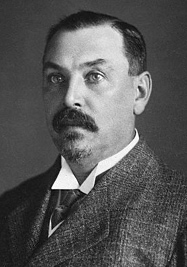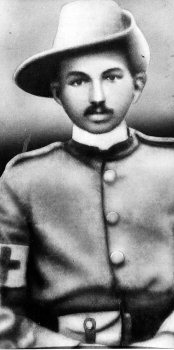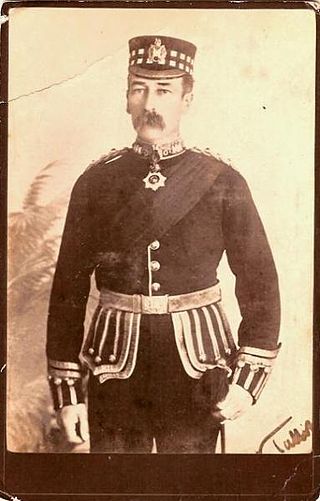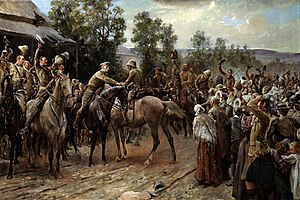
Louis Botha was a South African politician who was the first prime minister of the Union of South Africa – the forerunner of the modern South African state. A Boer war veteran during the Second Boer War, he eventually fought to have South Africa become a British Dominion.

Ladysmith is a city in the Uthukela District of KwaZulu-Natal, South Africa. It lies 230 kilometres (140 mi) north-west of Durban and 365 kilometres (227 mi) south-east of Johannesburg. Important industries in the area include food processing, textiles, and tyre production. Ladysmith is the seat for both the Alfred Duma Local Municipality and Uthukela District Municipality.

Estcourt is a town in the uThukela District of KwaZulu-Natal Province, South Africa. The main economic activity is farming with large bacon and processed food factories situated around the town. The N3 freeway passes close to the town, linking it to the rest of South Africa.

The Battle of Spion Kop was a military engagement between British forces and two Boer Republics, the South African Republic and the Orange Free State, during the campaign by the British to relieve the besieged city Ladysmith during the initial months of the Second Boer War. The battle was fought 23–24 January 1900 on the hilltop of Spioen Kop(a), about 38 km (24 mi) west-southwest of Ladysmith and resulted in a Boer victory.

The siege of Ladysmith was a protracted engagement in the Second Boer War, taking place between 2 November 1899 and 28 February 1900 at Ladysmith, Natal.
Colenso is a town in KwaZulu-Natal, South Africa. It is located on the southern bank of the Tugela River on the R103 road. The original settlement was contained within a loop on the river, but it subsequently expanded southwards and eastwards. It lies on the main Durban - Johannesburg railway line some 190 km (118 mi) north-west of Durban.

The Battle of Colenso was the third and final battle fought during the Black Week of the Second Boer War. It was fought between British and Boer forces from the independent South African Republic and Orange Free State in and around Colenso, Natal, South Africa on 15 December 1899.

The Great Boer War is a non-fiction work on the Boer War by Arthur Conan Doyle and first published in 1900 by Smith, Elder & Co. By the end of the war in 1902 the book had been published in 16 editions, constantly revised by Doyle. The Introduction describes the book as:
A very thorough account, including tables at the end of those killed or wounded up until the 8th September when he left South Africa. This account is compiled with as much accuracy as was attainable at this date, and with as much detail as a single volume will permit. In frequent conversations with Boers, Conan Doyle has endeavoured to get their views upon both political and military questions. Often the only documents he had to consult were the convalescent officers and men under his care, therefore some errors may have crept in. The closing scenes of the Boer War have necessarily been treated with less detail than the earlier.

The Battle of Vaal Krantz was the third failed attempt by General Redvers Buller's British army to fight its way past Louis Botha's army of Boer irregulars and lift the Siege of Ladysmith. The battle occurred during the Second Boer War.
The Battle of Ladysmith was one of the early engagements of the Second Boer War. A large British force which had concentrated at the garrison town of Ladysmith launched a sortie on 30 October 1899, against Boer armies which were slowly surrounding the town. The result was a disaster for the British. The main body was driven back into the town, and an isolated detachment of 800 men was forced to surrender to Commandant De Wet. The Boers did not follow up their advantage by proceeding towards the strategically important port of Durban, and instead began a siege of Ladysmith, which was relieved after 118 days. John Norwood was awarded the Victoria Cross for his actions during the battle.

The Battle of Tugela Heights, also known as the Battle of Pieters Hill, Battle of the Pieters, or the Battle of the Tugela River, consisted of a series of military actions lasting from 14 February through to 27 February 1900 in which General Sir Redvers Buller's British army forced Louis Botha's Boer army to lift the Siege of Ladysmith during the Second Boer War.

Spion Kop is a mountain in the province of KwaZulu-Natal, South Africa. It is located near the town of Ladysmith, 27 km to the WSW and about 2.5 km to the north of the Spioenkop Dam, a reservoir for the waters of the Tugela River.

The Natal Indian Ambulance Corps was created by Mahatma Gandhi for use by the British as stretcher bearers during the Second Boer War, with expenses met by the local Indian community. Gandhi and the corps served at the Battle of Spion Kop. It consisted of 300 free Indians and 800 indentured labourers. It was committed to saving the lives of Africans and Indians. Gandhi was bestowed with the 'Kaiser-i-Hind' and other medals by the British for his work in Boer war. This was given up by Gandhi after the Jallianwala Bagh massacre in 1919.
Major General Sir Geoffrey Barton, of the 7th Regiment of Foot, served the British Army from 1862 until 1904. Although he saw service in Ireland, Hong Kong and India, the majority of his campaigns were on the African continent. During the Second Boer War he was put in command of the 6th Brigade of the South Natal Field Force, taking part in the Relief of Ladysmith and the Relief of Mafeking. When he retired to Scotland he took an interest in local politics, the Red Cross Society and the Boy Scout Movement.

Major-General John Talbot Coke (1841–1912) of Trusley in South Derbyshire was a British Army officer who served in the 25th Foot between 1859 and 1901. He wrote a family history book called "Coke of Trusley, in the County of Derby, and Branches Therefrom; a Family History" which was published in 1880. He was a Brigade Commander during the Second Boer War having a prominent role in the battles of Spion Kop and the Tugela Heights during the relief of Ladysmith.
The Natal Field Force (NFF) was a multi-battalion field force originally formed by Major-General Sir George Pomeroy Colley in Natal for the First Boer War. It was later re-established for the Second Boer War (1899–1902) and commanded by Major-General Sir Redvers Buller VC GCB GCMG.
The South African Light Horse regiment of the British Army were raised in Cape Colony in 1899 and disbanded in 1907.

Boksburg Commando was a light infantry regiment of the South African Army. It formed part of the South African Army Infantry Formation as well as the South African Territorial Reserve.

The Prince Christian Victor Memorial is a war memorial on The Hoe in Plymouth. It was erected in 1902 to commemorate the death of Prince Christian Victor of Schleswig-Holstein, the eldest son of Queen Victoria's third daughter Princess Helena. He died of typhoid fever during the Second Boer War. It became a Grade II listed building in 1975.

Tobias Smuts was a Second Boer War Boer general and member of the Eerste Volksraad for the South African Republic.



















